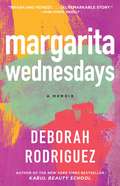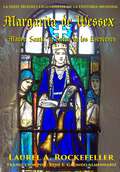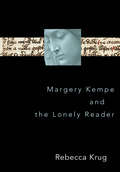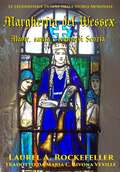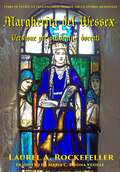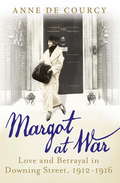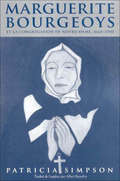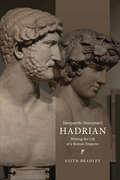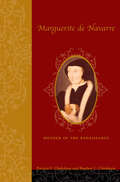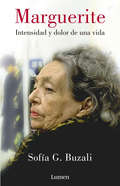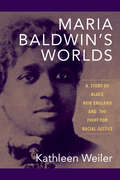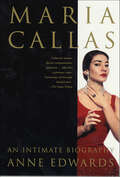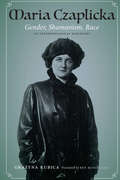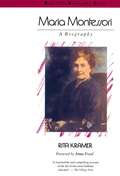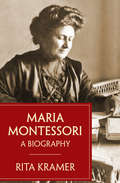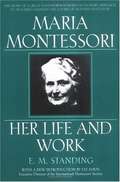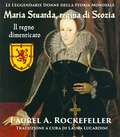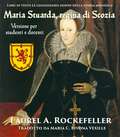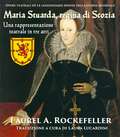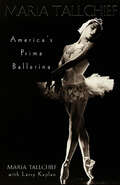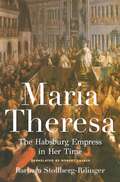- Table View
- List View
Margarita Wednesdays
by Deborah RodriguezIn answer to the question of what happened following her New York Times bestseller Kabul Beauty School, Deborah Rodriquez is back with a new memoir.Irreverent, insightful, and blatantly honest, Deborah takes us along on her inspiring journey of self-discovery and renewal after she is forced to flee Afghanistan in 2007. She first lands in California, where she feels like a misfit teetering on the brink of sanity. Where was that fearless redhead who stared danger in the face back in Kabul? After being advised to commune with glowworms and sit in contemplation for one year, Rodriguez finally packs her life and her cat into her Mini Cooper and moves to a seaside town in Mexico. Despite having no plan, no friends, and no Spanish, a determined Rodriguez soon finds herself swept up in a world where the music never stops and a new life can begin. Her adventures and misadventures among the expats and locals help lead the way to new love, new family, and a new sense of herself. In the magic of Mexico, she finds the hairdresser within, and builds the life she never knew was possible--a life on her own terms.
Margarita de Wessex: Madre, Santa, y Reina de los Escoceses (Mujeres Legendarias de la Historia del Mundo #10)
by Laurel A. RockefellerEl siglo XI fue una época peligrosa para pertenecer a la línea ininterrumpida del rey Æthelred II el Indeciso y su primera reina, Æfgifu de York. Nacida en Hungría tras el intento fallido del rey Canuto III de asesinar a su padre, Eduardo el Exiliado, Margarita vio cómo su vida daba un vuelco cuando el rey Eduardo el Confesor descubrió que su padre había sobrevivido, y la consiguiente devolución de su familia a Inglaterra. Convertida en un rehén político que sólo se mantenía vivo mientras sirviera a los intereses de los hombres poderosos, Margarita y su familia encontraron en la invitación del rey Máel Coluim mac Donnchadh Ceann Mhor a su corte en Dunfermline, en Alba, la respuesta largamente esperada a sus plegarias. Escocia nunca volvería a ser la misma.
Margery Kempe and the Lonely Reader
by Rebecca KrugSince its rediscovery in 1934, the fifteenth-century Book of Margery Kempe has become a canonical text for students of medieval Christian mysticism and spirituality. Its author was a fifteenth-century English laywoman who, after the birth of her first child, experienced vivid religious visions and vowed to lead a deeply religious life while remaining part of the secular world. After twenty years, Kempe began to compose with the help of scribes a book of consolation, a type of devotional writing found in late medieval religious culture that taught readers how to find spiritual comfort and how to feel about one's spiritual life. In Margery Kempe and the Lonely Reader, Rebecca Krug shows how and why Kempe wrote her Book, arguing that in her engagement with written culture she discovered a desire to experience spiritual comfort and to interact with fellow believers who also sought to live lives of intense emotional engagement.An unlikely candidate for authorship in the late medieval period given her gender and lack of formal education, Kempe wrote her Book as a revisionary act. Krug shows how the Book reinterprets concepts from late medieval devotional writing (comfort, despair, shame, fear, and loneliness) in its search to create a spiritual community that reaches out to and includes Kempe, her friends, family, advisers, and potential readers. Krug offers a fresh analysis of the Book as a written work and draws attention to the importance of reading, revision, and collaboration for understanding both Kempe’s particular decision to write and the social conditions of late medieval women’s authorship.
Margherita del Wessex: Madre, santa e regina di Scozia (Le leggendarie donne della storia mondiale #10)
by Laurel A. RockefellerIl secolo XI non era il momento migliore per un discendente diretto di re Etelredo lo Sconsigliato e della sua prima moglie Æfgifu di York. Nata in Ungheria, a seguito del fallito tentato omicidio di suo padre, Edoardo l’Esiliato, ordinato da re Canuto III, Margherita verrà inaspettatamente catapultata in Inghilterra, quando il suo prozio, re Edoardo il Confessore, apprenderà che Edoardo l’Esiliato è riuscito a sfuggire al tentato omicidio ordinato dal suo predecessore. Dopo alcuni anni, le sorti di Margherita e la sua famiglia vedranno un altro inaspettato colpo di scena, da ostaggi politici sotto i normanni, grazie ad una rocambolesca fuga, si ritroveranno ospiti di re King Máel Coluim mac Donnchadh Ceann Mhor a Dunfermline, capitale del regno di Alba. Con l’arrivo di Margherita, la Scozia non sarà mai più la stessa.
Margherita del Wessex: Versione per studenti e docenti (Le leggendarie donne della storia mondiale #10)
by Laurel A. RockefellerLa storia entusiasmante di Margherita del Wessex, moglie di Malcolm III Canmore, re del regno di Alba, prende vita in questa edizione per studenti e docenti appositamente creata per l’uso in aula e a casa. Le domande si prefiggono lo scopo di favorire la comprensione del testo ed il pensiero logico durante l’apprendimento della storia. In coda al testo vengono fornite appendici relative alla computazione del tempo in epoca medievale ed una dettagliatissima cronologia della storia scozzese che comprende eventi accaduti nell’arco di circa 3000 anni. Questo libro è uno strumento indispensabile nell’ampliamento della conoscenza storica. Adatto ad un pubblico dai 12 anni in poi.
Margot at War: Love and Betrayal in Downing Street, 1912-1916
by Anne de CourcyMargot Asquith was perhaps the most daring and unconventional Prime Minister's wife in British history. Known for her wit, style and habit of speaking her mind, she transformed 10 Downing Street into a glittering social and intellectual salon. Yet her last four years at Number 10 were a period of intense emotional and political turmoil in her private and public life. In 1912, when Anne de Courcy's book opens, rumblings of discontent and cries for social reform were encroaching on all sides - from suffragettes, striking workers and Irish nationalists. Against this background of a government beset with troubles, the Prime Minister fell desperately in love with his daughter's best friend, Venetia Stanley; to complicate matters, so did his Private Secretary. Margot's relationship with her husband was already bedevilled by her stepdaughter's jealous, almost incestuous adoration of her father. The outbreak of the First World War only heightened these swirling tensions within Downing Street. Drawing on unpublished material from personal papers and diaries, Anne de Courcy vividly recreates this extraordinary time when the Prime Minister's residence was run like an English country house, with socialising taking precedence over politics, love letters written in the cabinet room and gossip and state secrets exchanged over the bridge table. By 1916, when Asquith was forced out of office, everything had changed. For the country as a whole, for those in power, for a whole stratum of society, but especially for the Asquiths and their circle, it was the end of an era. Life inside Downing Street would never be the same again.
Margot at War: Love and Betrayal in Downing Street, 1912-1916
by Anne de CourcyMargot Asquith was perhaps the most daring and unconventional Prime Minister's wife in British history. Known for her wit, style and habit of speaking her mind, she transformed 10 Downing Street into a glittering social and intellectual salon. Yet her last four years at Number 10 were a period of intense emotional and political turmoil in her private and public life. In 1912, when Anne de Courcy's book opens, rumblings of discontent and cries for social reform were encroaching on all sides - from suffragettes, striking workers and Irish nationalists. Against this background of a government beset with troubles, the Prime Minister fell desperately in love with his daughter's best friend, Venetia Stanley; to complicate matters, so did his Private Secretary. Margot's relationship with her husband was already bedevilled by her stepdaughter's jealous, almost incestuous adoration of her father. The outbreak of the First World War only heightened these swirling tensions within Downing Street. Drawing on unpublished material from personal papers and diaries, Anne de Courcy vividly recreates this extraordinary time when the Prime Minister's residence was run like an English country house, with socialising taking precedence over politics, love letters written in the cabinet room and gossip and state secrets exchanged over the bridge table. By 1916, when Asquith was forced out of office, everything had changed. For the country as a whole, for those in power, for a whole stratum of society, but especially for the Asquiths and their circle, it was the end of an era. Life inside Downing Street would never be the same again.
Margot at War: Love and Betrayal in Downing Street, 1912-1916
by Anne de CourcyMargot Asquith was perhaps the most daring and unconventional Prime Minister's wife in British history. Known for her wit, style and habit of speaking her mind, she transformed 10 Downing Street into a glittering social and intellectual salon. Yet her last five years at Number 10 were a period of intense emotional and political turmoil in her private and public life. In 1912, when Anne de Courcy's book opens, rumblings of discontent and cries for social reform were encroaching on all sides - from suffragettes, striking workers and Irish nationalists. Against this background of a government beset with troubles, the Prime Minister fell desperately in love with his daughter's best friend, Venetia Stanley; to complicate matters, so did his Private Secretary. Margot's relationship with her husband was already bedevilled by her stepdaughter's jealous, almost incestuous adoration of her father. The outbreak of the First World War only heightened these swirling tensions within Downing Street. Drawing on unpublished material from personal papers and diaries, Anne de Courcy vividly recreates this extraordinary time when the Prime Minister's residence was run like an English country house, with socialising taking precedence over politics, love letters written in the cabinet room and gossip and state secrets exchanged over the bridge table. By 1916, when Asquith was forced out of office, everything had changed. For the country as a whole, for those in power, for a whole stratum of society, but especially for the Asquiths and their circle, it was the end of an era. Life inside Downing Street would never be the same again.Read by Patricia Gallimore(p) 2015 Isis Publishing Ltd
Marguerite Bourgeoys et la Congrégation de Notre Dame, 1665-1670
by Patricia SimpsonMarguerite Bourgeoys (1620-1700) was canonized in 1982. Patricia Simpson goes beyond myth and hagiography to explore Bourgeoys's dream of establishing a radically new religious community of women, recounting her thirty-year struggle to obtain official recognition for the Congrégation of Notre-Dame. Simpson shows that the order faced great resistance from the male Church hierarchy despite the fact that the pioneer society depended on the work of the Congrégation. The order was particularly important in assuming the guardianship of many filles du roi - young women sent to New France under royal auspices to be married to the men of the colony. Simpson also examines the many difficulties the Congrégation faced, which included natural disasters and the dangers involved in trying to reach women and children in settlements throughout New France, as far away as Acadia.
Marguerite Yourcenar’s Hadrian: Writing the Life of a Roman Emperor (Phoenix Supplementary Volumes #62)
by Keith BradleyMarguerite Yourcenar is best known as the author of the 1951 novel Mémoires d’Hadrien, her recreation of the life of the Roman emperor Hadrian. The work can be examined from the perspective of the issues raised by writing Roman imperial biography at large and the many ways in which Mémoires has a claim to historical authenticity. In Marguerite Yourcenar’s Hadrian, Keith Bradley explains how Mémoires d’Hadrien came to be written, gives details of Yourcenar’s own biography, and describes some of the intricate historical problems that her novel’s portrait of Hadrian presents. He draws on Yourcenar’s correspondence, her interviews with journalists, and her literary corpus as a whole, emphasizing Yourcenar’s profound knowledge of the ancient evidence on which her life of Hadrian is based and exploiting a wide range of contemporary Yourcenarian criticism. The book pays special attention to the methods by which Yourcenar believed Hadrian’s life history to be recoverable, compares examples of modern life-writing, and contrasts the procedures of conventional Roman biographers. Revealing how and why Mémoires d’Hadrien is as it is, Marguerite Yourcenar’s Hadrian illustrates how imaginative literary recreation is often little different from historical speculation.
Marguerite de Navarre (1492–1549): Mother of the Renaissance
by Rouben Cholakian Patricia Francis CholakianSister to the king of France, queen of Navarre, gifted writer, religious reformer, and patron of the arts—in her many roles, Marguerite de Navarre (1492-1549) was one of the most important figures of the French Renaissance. In this, the first major biography in English, Patricia F. Cholakian and Rouben C. Cholakian draw on her writings to provide a vivid portrait of Marguerite's public and private life. Freeing her from the shadow of her brother François I, they recognize her immense influence on French politics and culture, and they challenge conventional views of her family relationships.The authors highlight Marguerite's considerable role in advancing the cause of religious reform in France-her support of vernacular translations of sacred works, her denunciation of ecclesiastical corruption, her founding of orphanages and hospitals, and her defense and protection of persecuted reformists. Had this plucky and spirited woman not been sister to the king, she would most likely have ended up at the stake. Though she remained a devout catholic, her theological poem Miroir de l'âme pécheresse, a mystical summa of evangelical doctrine that was viciously attacked by conservatives, remains to this day an important part of the Protestant corpus. Marguerite, along with her brother the king, was a key architect and animator of the refined entertainments that became the hallmark of the French court. Always eager to encourage new ideas, she supported many of the illustrious writers and thinkers of her time. Moreover, uniquely for a queen, she was herself a prolific poet, dramatist, and prose writer and published a two-volume anthology of her works. In reassessing Marguerite's enormous oeuvre, the authors reveal the range and quality of her work beyond her famous collection of tales, posthumously called the Heptaméron. The Cholakians' groundbreaking reading of the rich body of her work, which uncovers autobiographical elements previously unrecognized by most scholars, and their study of her surviving correspondence portray a life that fully justifies Marguerite's sobriquet, "Mother of the Renaissance."
Marguerite: Intensidad y dolor de una vida
by Sofía G. BuzaliUna excepcional biografía novelada donde se recrea la vida de Marguerite Duras: sus creaciones literarias, sus amores, el intenso drama personal, la soledad y las tribulaciones de sus últimos días. La historia comienza en un hospital parisino donde Marguerite Duras ha sido internada de emergencia para someterse a una desintoxicación alcohólica. En la habitación, la escritora se enfrenta a una fatal realidad: como no puede beber, llora. Así, desempolva sus recuerdos ante Yann, su joven amante, quien ha cuidado de ella durante los últimos años. De ese modo, el lector va descubriendo página tras página el drama de una vida llena de intensidad y dolor: desde la compleja infancia de Duras en Indochina, pasando por su temprana formación académica, en los días en los que la llamaban "la zorra más joven de Saigón", hasta su incursión en el partido comunista francés y su consagración en la historia de la literatura con obras como Hiroshima mon amour oEl amante. Por medio de dos voces narrativas magistralmente entrelazadas, se despliega al mismo tiempo un emotivo retrato de posguerra por el que desfilan personajes tan diversos como Robert Antelme -uno de los grandes amores de Marguerite-, François Mitterrand, Edgar Morin, Jorge Semprún, Jean Paul Sartre, Simone de Beauvoir, Albert Camus o el propio Jacques Lacan, quien le comunicó a Duras que no necesitaba volver a visitarlo, pues había hallado la solución que la salvaría: escribir.
Maria Baldwin's Worlds: A Story of Black New England and the Fight for Racial Justice
by Kathleen Weiler“This well-written biography of an intriguing black educator is strong on narrative, recovering Baldwin’s life from obscurity with sound scholarship” (Jeffrey Aaron Snyder, author of Making Black History).In the late nineteenth century, Maria Baldwin established a unique place for herself as a highly respected educator at a largely white New England school. She also used her social standing to advance the African American cause. As an activist, she carried on the radical spirit of the Boston area’s renowned abolitionists. In Maria Baldwin’s Worlds, Kathleen Weiler reveals both Baldwin’s victories and what fellow activist W. E. B. Du Bois called her “quiet courage” in everyday life, in the context of the wider black freedom struggle in New England.African American sociologist Adelaide Cromwell called Baldwin “the lone symbol of Negro progress in education in the greater Boston area” during her lifetime. Baldwin fought alongside more radical activists like William Monroe Trotter for full citizenship for fellow members of the black community. And, in her professional and personal life, she negotiated and challenged dominant white ideas about black womanhood.
Maria Callas: An Intimate Biography
by Anne EdwardsFrom the New York Times bestselling biographer Anne Edwards comes the irresistible true story of the lives and loves of the great opera diva, Maria Callas.Maria Callas continues to mesmerize us decades after her death, not only because she was indisputably the greatest opera diva of the 20th century, but also because both her life and death were shrouded in a Machiavellian web of scandal, mystery and deception. Now Anne Edwards, well known for her revealing and insightful biographies of some of the world's most noted women, tells the intimate story of Maria Callas—her loves, her life, and her music, revealing the true woman behind the headlines, gossip and speculation.The second daughter of Greek immigrant parents, Maria found herself in the grasp of an overwhelmingly ambitious mother who took her away from her native New York and the father she loved, to a Greece on the eve of the Second World War. From there, we learn of the hardships, loves and triumphs Maria experienced in her professional and personal life. We are introduced to the men who marked Callas forever—Luchino Visconti, the brilliant homosexual director who she loved hopelessly, Giovanni Battista Meneghini, the husband thirty years her senior who used her for his own ambitions, as had her mother, and Aristotle Onassis, who put an end to their historic love affair by discarding her for the widowed Jacqueline Kennedy. Throughout her life, Callas waged a constant battle with her weight, a battle she eventually won, transforming herself from an ugly duckling into the slim and glamorous diva who transformed opera forever, whose recordings are legend, and whose life is the stuff of which tabloids are made. Anne Edwards goes deeper than previous biographies of Maria Callas have dared. She draws upon intensive research to refute the story of Callas's "mystery child" by Onassis, and she reveals the true circumstances of the years preceding Callas's death, including the deception perpetrated by her close and trusted friend. As in her portraits of other brilliant, star-crossed women, Edwards brings Maria Callas—the intimate Callas—alive.
Maria Callas: The Woman Behind the Legend
by Arianna StassinopoulosLegendary soprano Maria Callas, whose singing was as sensational as her life, is the subject of this biography. The author tells of Callas' transformation from a shy, chubby girl into one of the greatest opera singers.
Maria Czaplicka: Gender, Shamanism, Race (Critical Studies in the History of Anthropology)
by Grazyna KubicaThis biography of the Polish British anthropologist Maria Czaplicka (1884–1921) is also a cultural study of the dynamics of the anthropological collective presented from a researcher-centric perspective. Czaplicka, together with Bronisław Malinowski, studied anthropology in London and later at Oxford, then she headed the Yenisei Expedition to Siberia (1914–15) and was the first female lecturer of anthropology at Oxford. She was an engaged feminist and an expert on political issues in Northern Asia and Eastern Europe. But this remarkable woman&’s career was cut short by suicide. Like many women anthropologists of the time, Czaplicka journeyed through various academic institutions, and her legacy has been dispersed and her field materials lost. Grażyna Kubica covers the major events in Czaplicka&’s life and provides contextual knowledge about the intellectual formation in which Czaplicka grew up, including the Warsaw radical intelligentsia and the contemporary anthropology of which she became a part. Kubica also presents a critical analysis of Czaplicka&’s scientific and literary works, related to the issues of gender, shamanism, and race. Kubica shows how Czaplicka&’s sense of agency and subjectivity enriched and shaped the practice of anthropology and sheds light on how scientific knowledge arises and is produced.
Maria Montessori: A Biography
by Rita KramerMaria Montessori brought about a revolution in the classroom. She developed a method of teaching small children and inspired a movement that carried that method into every corner of the world. In her rich and forthright biography, Rita Kramer brings this powerful woman to life, illuminating not only her lasting contributions to child development and social reform, but also the controversies surrounding her training methods and private life.
Maria Montessori: A Biography
by Rita KramerThe definitive biography of a physician, feminist, social reformer, educator, and one of the most influential, and controversial women of the 20th century. Maria Montessori effected a worldwide revolution in the classroom. She developed a new method of educating the young and inspired a movement that carried it into every corner of the world. This is the story of the woman behind the public figure—her accomplishments, her ideas, and her passions. Montessori broke the mold imposed on women in the nineteenth century and forged a new one, first for herself and eventually for those who came after her. Against formidable odds she became the first woman to graduate from the medical school of the University of Rome and then devoted herself to the condition of children considered uneducable at the time. She developed a teaching method that enabled them to do as well as normal children, a method which then led her to found a new kind of school—the Casa dei Bambini, or House of Children—which gained her worldwide fame and still pervades classrooms wherever young children learn. This biography is not only the story of a groundbreaking feminist but a vital chapter in the history of education.&“Highly recommended for educators, parents, and moderate feminists who seek inspiration from one of the most accomplished women of this or any other age.&”—Publishers Weekly
Maria Montessori: Her Life And Work
by E. M. StandingMaria Montessori is important background reading for parents considering Montessori education for their children, as well as for those training to become Montessori teachers. The first woman to win a degree as a Doctor of Medicine in Italy in 1896, Maria Montessori's mission to improve children's education began in the slums of Rome in 1907, and continued throughout her lifetime. Her insights into the minds of children led her to develop prepared environments and other tools and devices that have come to characterize Montessori education today. Her influence in other countries has been profound and many of her teaching methods have been adopted by educators generally. Part biography and part exposition of her ideas, this engaging book reveals through her letters and personal diaries Maria Montessori's humility and delight in the success of her educational experiments and is an ideal introduction to the principals and practices of the greatest educational pioneer of the 20th century. The new introduction to Maria Montessori: Her Life and Work by Lee Havis, executive director of the International Montessori Society, discusses the changes that have taken place in Montessori education within recent years.
Maria Stuarda regina di Scozia: il regno dimenticato
by Laurel A. Rockefeller Traduzione a cura di Laura LucardiniLa regina Maria Stuarda è stata una delle donne più amate e controverse della storia scozzese. Nipote di re Giacomo IV e di sua moglie Margherita Tudor, la posizione di Maria quale erede apparente al trono inglese e la violenza della Riforma scozzese fanno da sfondo a una delle vite più drammatiche e incomprese del 16° secolo. Maria regina di Scozia racconta la vera storia di Maria, concentrandosi principalmente sul suo regno, celebrando la sua vita più che la sua morte e dimostrandoci come Maria fosse una donna che precorreva i suoi tempi. Una biografia della serie "Le leggendarie donne della storia mondiale".
Maria Stuarda, Regina di Scozia: Versione per studenti e docenti (Libri di testo Le leggendarie donne della storia mondiale #3)
by Laurel A. RockefellerLa regina Maria Stuarda è la più amata, ed allo stesso tempo, controversa figura femminile di tutta la storia scozzese. Maria, in quanto nipote di re James IV e Margaret Tudor, deteneva diritti d’ascensione al trono d’Inghilterra; tale posizione di erede legittima alla corona inglese, assieme alle violenze della Riforma scozzese, sono alla base di una delle esistenze più drammatiche e fraintese di tutto il XVI secolo. Maria Stuarda, Regina di Scozia, ne racconta la vera storia, concentrandosi principalmente sul suo regno e celebrandone la vita piuttosto che la morte, oltre che a mostrare come Maria fosse una donna all’avanguardia per il suo tempo. La versione per studenti e docenti include: domande d’approfondimento alla fine di ogni capitolo, una dettagliata cronologia ed una vasta lista di letture consigliate.
Maria Stuarda, regina di Scozia: una rappresentazione teatrale in tre atti
by Laurel A. Rockefeller Laura LucardiniLa tragica storia della regina Maria Stuarda diventa un'opera teatrale in questa coinvolgente tragedia che ne racconta la vita, gli amori e il regno. Un'opera perfetta per le scuole e le compagnie amatoriali. Include bibliografia e cronologia degli eventi. Durata: 60-80 minuti.
Maria Tallchief: America's Prima Ballerina
by Maria Tallchief Larry KaplanRead the story of the legendary ballerina who now adorns a $1 coin and a US quarter!A fascinating self-portrait of the fairy-tale life of a woman who understood that a committed talent could transform the world around her."Maria Tallchief and American ballet came of age in the same moment.... Her story will always be the story of ballet conquering America. It was and is an American romance."-Arlene Croce, The New Yorker
Maria Theresa: The Habsburg Empress in Her Time
by Barbara Stollberg-RilingerA major new biography of the iconic Austrian empress that challenges the many myths about her life and ruleMaria Theresa (1717–1780) was once the most powerful woman in Europe. At the age of twenty-three, she ascended to the throne of the Habsburg Empire, a far-flung realm composed of diverse ethnicities and languages, beset on all sides by enemies and rivals. Barbara Stollberg-Rilinger provides the definitive biography of Maria Theresa, situating this exceptional empress within her time while dispelling the myths surrounding her.Drawing on a wealth of archival evidence, Stollberg-Rilinger examines all facets of eighteenth-century society, from piety and patronage to sexuality and childcare, ceremonial life at court, diplomacy, and the everyday indignities of warfare. She challenges the idealized image of Maria Theresa as an enlightened reformer and mother of her lands who embodied both feminine beauty and virile bellicosity, showing how she despised the ideas of the Enlightenment, treated her children with relentless austerity, and mercilessly persecuted Protestants and Jews. Work, consistent physical and mental discipline, and fear of God were the principles Maria Theresa lived by, and she demanded the same from her family, her court, and her subjects.A panoramic work of scholarship that brings Europe's age of empire spectacularly to life, Maria Theresa paints an unforgettable portrait of the uncompromising yet singularly charismatic woman who left her enduring mark on the era in which she lived and reigned.
